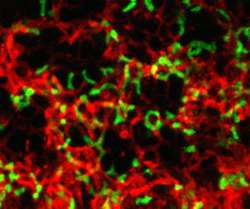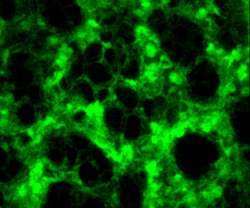New imaging advance illuminates immune response in breathing lung

(PhysOrg.com) -- Fast-moving objects create blurry images in photography, and the same challenge exists when scientists observe cellular interactions within tissues constantly in motion, such as the breathing lung. In a recent UCSF-led study in mice, researchers developed a method to stabilize living lung tissue for imaging without disrupting the normal function of the organ. The method allowed the team to observe, for the first time, both the live interaction of living cells in the context of their environment and the unfolding of events in the immune response to lung injury.
The finding impacts disease research, the authors say, because the ability to image the lung and other organs with minimum tissue disruption allows scientists to look deeper into the many physiological aspects of injury and diseases like diabetes or cancer.
"The nature of disease is complex, so if scientists can observe in real-time what's happening in tumors or immune responses as they occur, we can find new ways to intervene," said senior author Max Krummel, PhD, UCSF associate professor of Pathology, whose lab developed the new imaging technique for seeing minute details of cellular interaction in tissues.
"We figured out a method for holding cells still enough to image them without interrupting their normal processes. This enabled us to observe cellular events as they happen naturally rather than the usual way, which is to stop the motion of cellular processes in order to photograph them."
The research, published online this week in Nature Methods, includes videos of these immune cell interactions.
To achieve such clear imaging of the fast-moving lung cells, the team developed a custom rig device that applies a gentle amount of suction to the tissue surface, holding the region for viewing inside the range of their microscope. They then used super-fast imaging with a two-photon microscope to photograph the tissue. Footage was taken 30 times each second, revealing the full progression of cellular participants involved in different biological processes – for example: which cells worked together to mount a response to an injury. With that information, the team was able to identify the function of different cell types.
The fast, two-photon microscopy technique previously was developed by the team to monitor immune cells in the lymph nodes and other biological processes. Two-photon microscopy is a light-based high-resolution imaging technology using infrared pulsed lasers to penetrate deep into tissue layers, capturing details as small as one micron (or one ten-thousandth of a centimeter) in diameter. The study uses custom-built microscopes that the team constructed on-site at UCSF.
With more than 20 previously published articles using microscopy, the team is focused on continuing to improve the ability to observe molecules and cells deep within tissues.
"Imaging tissues or organs is ideally done within the living organism and as noninvasively as possible, but there are many challenges," said Mark R. Looney, MD, co-first author and assistant professor in Medicine and Laboratory Medicine at UCSF.
"Light is absorbed and scattered as it passes through tissue, which degrades image quality. And even anesthetized animals have vascular and respiratory movements, complicating the imaging of dynamic processes. Many of these problems are exacerbated in the lung," said Emily Thornton, co-first author and a graduate student in Krummel's laboratory.
Although the lung is a challenging organ to image, it is the site of several important biological functions useful in the study of diseases. For instance, the lung is where the body's internal systems encounter the outside environment through the inhalation of air, allergens, toxins and pathogens. The lung also is in constant contact with inhaled air and with circulating blood cells.

"As a result of achieving video-rate imaging of events within the lung, we've shown how the immune system behaves during normal function and how tissues are affected in acute lung injury," Looney said. "For other disease processes in other organs, we hope to define how collections of cells participate and how they're organized."
In the future, the team plans to miniaturize the stabilizing rig in order to image live tissue biopsies.
"Many different specialties of clinical scientists and pathologists can use this imaging method to learn how disease progression unfolds, but miniaturizing the rig to image biopsied tissue would be a tremendous improvement," Krummel said. "In real-time, for instance, we can catch how cells interact with tumors and observe whether they promote growth or rejection, and whether medical therapy is working."

















